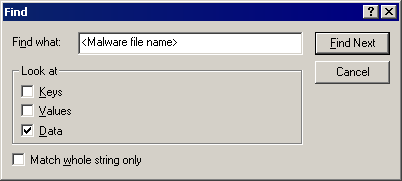BKDR_AFCORE.DI
Troj/Backdr-EX (Sophos)
Windows 2000, Windows XP, Windows Server 2003


Threat Type: Backdoor
Destructiveness: No
Encrypted: No
In the wild: Yes
OVERVIEW
This backdoor monitors the browsing activities of the user and logs keystroke when the user is accessing sites with certain strings.
This backdoor arrives on a system as a file dropped by other malware or as a file downloaded unknowingly by users when visiting malicious sites.
It may be injected into processes running in memory.
It opens a random port to allow a remote user to connect to the affected system. Once a successful connection is established, the remote user executes commands on the affected system.
It requires its main component to successfully perform its intended routine.
TECHNICAL DETAILS
173,056 bytes
DLL
Yes
01 Apr 2011
Steals information
Arrival Details
This backdoor arrives on a system as a file dropped by other malware or as a file downloaded unknowingly by users when visiting malicious sites.
Installation
This backdoor drops the following non-malicious files:
- %System%\{random filename 1}.dat
- %System%\{random filename 2}.dat
- %System%\{random filename 3}.dat
- %System%\{random filename 4}.dat
- %Current%\{malware filename}.dat
(Note: %System% is the Windows system folder, which is usually C:\Windows\System on Windows 98 and ME, C:\WINNT\System32 on Windows NT and 2000, or C:\Windows\System32 on Windows XP and Server 2003.)
It drops the following copies of itself into the affected system:
- %System%\{random filename 1}.ocx
(Note: %System% is the Windows system folder, which is usually C:\Windows\System on Windows 98 and ME, C:\WINNT\System32 on Windows NT and 2000, or C:\Windows\System32 on Windows XP and Server 2003.)
It may be injected into processes running in memory.
Autostart Technique
This backdoor adds the following registry entries to enable its automatic execution at every system startup:
HKEY_CLASSES_ROOT\CLSID\{random CLSID}\
InprocServer32
(default} = {malware path and filename}
HKEY_CLASSES_ROOT\CLSID\{random CLSID}\
InprocServer32
(default) = %System%\{random filename 1}.ocx
Other System Modifications
This backdoor adds the following registry keys as part of its installation routine:
HKEY_CLASSES_ROOT\CLSID\{random CLSID}
HKEY_LOCAL_MACHINE\SOFTWARE\Microsoft\
Windows\CurrentVersion\Explorer\
ShellIconOverlayIdentifiers\{malware filename}
HKEY_LOCAL_MACHINE\SOFTWARE\Microsoft\
Windows\CurrentVersion\Explorer\
ShellIconOverlayIdentifiers\{random filename 1}
Backdoor Routine
This backdoor opens a random port to allow a remote user to connect to the affected system. Once a successful connection is established, the remote user executes commands on the affected system.
Other Details
This backdoor requires its main component to successfully perform its intended routine.
NOTES:
It may perform the following actions:
- Create, list, and delete cookies
- Flood drives
- Get IPC, log, and hook timeouts
- Manipulate files
- Obtain various system information (i.e., local time, drive information, idle time)
- Perform distributed denial of service (DDoS) attack against a target site
- Resolve host names
- Respawn or uninstall itself
- Restart Windows
- Turn off the system
It monitors the following applications:
- explorer.exe
- iexplore.exe
- firefox.exe
- opera.exe
- skype.exe
It also monitors the browsing activities of the user and logs keystroke when the user is accessing sites with the following strings:
- *.nhs.net/*
- *.nhs.uk/*
- *.hilton.*
- *.yahoo.*
- *.google.*
SOLUTION
8.900
Step 1
For Windows XP and Windows Server 2003 users, before doing any scans, please make sure you disable System Restore to allow full scanning of your computer.
Step 2
Scan your computer with your Trend Micro product and note files detected as BKDR_AFCORE.DI
Step 3
Restart in Safe Mode
Step 4
Delete the created random CLSID key
Important: Editing the Windows Registry incorrectly can lead to irreversible system malfunction. Please do this step only if you know how or you can ask assistance from your system administrator. Else, check this Microsoft article first before modifying your computer's registry.
Step 5
Delete this registry key
Important: Editing the Windows Registry incorrectly can lead to irreversible system malfunction. Please do this step only if you know how or you can ask assistance from your system administrator. Else, check this Microsoft article first before modifying your computer's registry. Before you could do this, you must restart in Safe Mode. For instructions on how to do this, you may refer to this page If the preceding step requires you to restart in safe mode, you may proceed to edit the system registry.
- In HKEY_LOCAL_MACHINE\SOFTWARE\Microsoft\Windows\CurrentVersion\Explorer\ShellIconOverlayIdentifiers
- {malware filename}
- {malware filename}
- In HKEY_LOCAL_MACHINE\SOFTWARE\Microsoft\Windows\CurrentVersion\Explorer\ShellIconOverlayIdentifiers
- {random filename 1}
- {random filename 1}
Step 6
Scan your computer with your Trend Micro product to delete files detected as BKDR_AFCORE.DI. If the detected files have already been cleaned, deleted, or quarantined by your Trend Micro product, no further step is required. You may opt to simply delete the quarantined files. Please check this Knowledge Base page for more information.
Did this description help? Tell us how we did.


